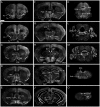Neuroanatomical characterisation of the expression of the lipodystrophy and motor-neuropathy gene Bscl2 in adult mouse brain
- PMID: 23049863
- PMCID: PMC3458087
- DOI: 10.1371/journal.pone.0045790
Neuroanatomical characterisation of the expression of the lipodystrophy and motor-neuropathy gene Bscl2 in adult mouse brain
Abstract
The endoplasmic reticulum localised protein seipin, encoded by the gene Berardinelli-Seip congenital lipodystrophy type 2 (BSCL2), serves a critical but poorly defined function in the physiology of both adipose and neural tissue. In humans, BSCL2 loss-of-function mutations cause a severe form of lipodystrophy, whilst a distinct set of gain-of-toxic-function mutations are associated with a heterogeneous group of neuropathies. However, despite the importance of seipin dysfunction to the pathophysiology of these conditions, little is known about its physiological role in adipocytes or neurons. BSCL2 mRNA has previously been identified in human and mouse brain, yet no definitive assessment of its expression has been undertaken. Here we comprehensively characterised the neuroanatomical distribution of mouse Bscl2 using complementary in situ hybridisation histochemistry and immunohistochemistry techniques. Whilst Bscl2 was broadly expressed throughout the rostral-caudal extent of the mouse brain, it exhibited a discrete neuroanatomical profile. Bscl2 was most abundantly expressed in the hypothalamus and in particular regions associated with the regulation of energy balance including, the paraventricular, ventromedial, arcuate and dorsomedial nuclei. Bscl2 expression was also identified within the brainstem dorsal vagal complex, which together with the paraventricular nucleus of the hypothalamus represented the site of highest expression. Further neurochemical profiling of these two nuclei revealed Bscl2/seipin expression within energy balance related neuronal populations. Specifically, seipin was detected in oxytocin neurons of the paraventricular nucleus of the hypothalamus and in catecholamine neurons of the dorsal vagal complex. These data raise the possibility that in addition to its role in adipose tissue development, seipin may also be involved in the central regulation of energy balance.
Conflict of interest statement
Figures






Similar articles
-
Adipose specific disruption of seipin causes early-onset generalised lipodystrophy and altered fuel utilisation without severe metabolic disease.Mol Metab. 2018 Apr;10:55-65. doi: 10.1016/j.molmet.2018.01.019. Epub 2018 Jan 31. Mol Metab. 2018. PMID: 29459250 Free PMC article.
-
The lipodystrophy protein seipin is found at endoplasmic reticulum lipid droplet junctions and is important for droplet morphology.Proc Natl Acad Sci U S A. 2007 Dec 26;104(52):20890-5. doi: 10.1073/pnas.0704154104. Epub 2007 Dec 18. Proc Natl Acad Sci U S A. 2007. PMID: 18093937 Free PMC article.
-
The human lipodystrophy gene product Berardinelli-Seip congenital lipodystrophy 2/seipin plays a key role in adipocyte differentiation.Endocrinology. 2009 Oct;150(10):4552-61. doi: 10.1210/en.2009-0236. Epub 2009 Jul 2. Endocrinology. 2009. PMID: 19574402 Free PMC article.
-
Function of seipin: new insights from Bscl2/seipin knockout mouse models.Biochimie. 2014 Jan;96:166-72. doi: 10.1016/j.biochi.2013.06.022. Epub 2013 Jul 2. Biochimie. 2014. PMID: 23831461 Review.
-
Role of Seipin in Human Diseases and Experimental Animal Models.Biomolecules. 2022 Jun 17;12(6):840. doi: 10.3390/biom12060840. Biomolecules. 2022. PMID: 35740965 Free PMC article. Review.
Cited by
-
Focus on progressive myoclonic epilepsy in Berardinelli-Seip syndrome.Neurol Sci. 2020 Nov;41(11):3345-3348. doi: 10.1007/s10072-020-04418-1. Epub 2020 May 21. Neurol Sci. 2020. PMID: 32440981
-
Female adipose tissue-specific Bscl2 knockout mice develop only moderate metabolic dysfunction when housed at thermoneutrality and fed a high-fat diet.Sci Rep. 2018 Dec 14;8(1):17863. doi: 10.1038/s41598-018-36078-9. Sci Rep. 2018. PMID: 30552349 Free PMC article.
-
Echinacoside's nigrostriatal dopaminergic protection against 6-OHDA-Induced endoplasmic reticulum stress through reducing the accumulation of Seipin.J Cell Mol Med. 2017 Dec;21(12):3761-3775. doi: 10.1111/jcmm.13285. Epub 2017 Aug 2. J Cell Mol Med. 2017. PMID: 28767194 Free PMC article.
-
Neurochemical Characterization of Brainstem Pro-Opiomelanocortin Cells.Endocrinology. 2020 Apr 1;161(4):bqaa032. doi: 10.1210/endocr/bqaa032. Endocrinology. 2020. PMID: 32166324 Free PMC article.
-
Impairment of respiratory muscle strength in Berardinelli-Seip congenital lipodystrophy subjects.Respir Res. 2018 Sep 12;19(1):173. doi: 10.1186/s12931-018-0879-8. Respir Res. 2018. PMID: 30208912 Free PMC article.
References
-
- Fei W, Du X, Yang H (2011) Seipin, adipogenesis and lipid droplets. Trends Endocrinol Metab 22: 204–210. - PubMed
-
- Ito D, Suzuki N (2009) Seipinopathy: a novel endoplasmic reticulum stress-associated disease. Brain 132: 8–15. - PubMed
-
- Rochford JJ (2010) Molecular mechanisms controlling human adipose tissue development: insights from monogenic lipodystrophies. Expert Rev Mol Med 12: e24. - PubMed
-
- Magre J, Delepine M, Khallouf E, Gedde-Dahl T Jr, Van Maldergem L, et al. (2001) Identification of the gene altered in Berardinelli-Seip congenital lipodystrophy on chromosome 11q13. Nat Genet 28: 365–370. - PubMed
Publication types
MeSH terms
Substances
Grants and funding
LinkOut - more resources
Full Text Sources
Molecular Biology Databases

